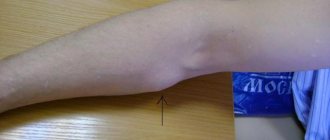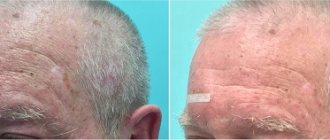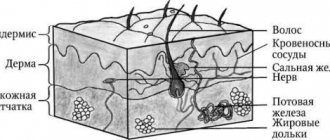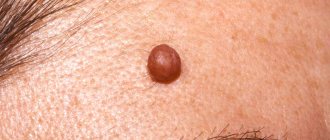Lipoma and skin atheroma are two common types of benign neoplasms. They require exceptionally attentive treatment, since in some cases (though, fortunately, not often) they can degenerate into malignant tumors. The appearance of atheroma may not cause suspicion - at first it usually does not cause much inconvenience. However, even if the tumor is not painful, you should still see a doctor. Often a lump (lipoma) on the neck or scalp gradually increases in size, in this case you need to visit a doctor urgently - the new growth will need to be examined to determine whether there is a risk of developing cancer.
Lipoma and atheroma are often similar in appearance, and patients often do not distinguish them from each other, defining them under the general name “wen.” Let's try to figure out what the difference is between a lipoma and an atheroma, and also what to do if you have one of these formations.
Lipoma
This is a benign formation consisting of adipose tissue. In essence, it is a local accumulation of adipose tissue under the skin. Lipoma is a benign tumor, although in rare cases, liposarcoma, a malignant formation, can develop under its mask.
Lipomas manifest themselves in the form of soft-elastic subcutaneous formations, mobile, painless, and can slowly increase in size. The skin over lipomas is not changed and easily moves over them. Small lipomas are not visible at all; they can only be detected by palpation. Larger lipomas stand out as “bumps” of round or oval shape. The size of lipomas is very variable - from 1-2 cm to 20 cm or more. Lipomas never become inflamed or suppurate.
Atheroma
The origin of atheroma is fundamentally different from lipomas. Atheroma develops from the sebaceous glands of the skin. For various reasons, the gland duct becomes clogged, secretion accumulates in the gland, which gradually begins to increase in size. Atheroma is defined as a small (from 0.5 to 2 - 3 cm) formation, which always rises somewhat above the skin and is always fused to it (i.e. the skin above the atheroma does not move), and can grow slowly. Atheroma always has a capsule and contains atheromatous masses resembling crushed lard.
Because The atheroma is connected to the external environment by a duct; there is always a threat that it will become infected through the duct and suppuration will occur. In this situation, moderate pain appears in the area of the previously “quiet” atheroma, the formation quickly (over several days) increases in size, redness appears around it, and body temperature may rise. Suppuration of atheroma requires urgent surgery.
How likely is the development of a secondary tumor focus?
The likelihood of metastases depends on a number of factors:
- Type of cancer. There are a number of oncological diseases where metastasis is a rare phenomenon (for example, basal cell carcinoma), while in others, on the contrary, they develop rapidly (for example, melanoma).
- Characteristics of the disease are molecular and genetic.
- Stage of cancer. The higher it is, the higher the likelihood of developing a secondary malignant focus.
- Localization.
- Specifics of growth. Tumors that grow infiltratively metastasize more often and faster than malignant neoplasms that grow superficially.
Symptoms
Identifying the problem in both cases is usually not difficult.
Signs of lipoma:
- mobile and painless, sizes can range from a few millimeters to 10-15 cm;
- to the touch - doughy or dense;
- not fused to the skin - the skin easily moves over the formation;
- never becomes inflamed – i.e. There is no redness or swelling of the skin above the lipoma.
Most often, lipomas are located on the limbs, head and torso; they are almost never on the face.
Symptoms of atheroma
The formation is in the form of a tubercle, painless, mobile, fused to the skin, you can often see the opening of the excretory duct of the gland. Most often, the “bump” is located on areas of the body where there is hair: on the face, scalp, in the genital area, on the legs, on the back, and is found on the face. If a suppurating atheroma appears, the formation increases in size over several days, the skin on the affected area may turn red and become painful, and the temperature may also rise.
Treatment
Now that we have figured out the difference between a lipoma and an atheroma, let’s move on to the next question: is it necessary to remove the lipoma or remove the atheroma? Let's start with the fact that conservative treatment of lipoma, as well as treatment of atheroma, is absolutely futile. Moreover, aggressive influence on these formations using various “folk” remedies can cause suppuration of atheroma, as well as malignancy (malignancy) of lipoma.
Tactical approaches to the treatment of lipoma are as follows: if the lipoma is small (2-3 cm), does not grow and does not cause any inconvenience (does not rub against clothes, is not a cosmetic defect, etc.), then it does not need to be removed. In case of growth (especially rapid growth), it is better to go for surgery. If the lipoma grows, then sooner or later you will still have to remove it, but it is better to do this while it is small in order to avoid large incisions and traumatic intervention. Any removed lipoma should be sent for histological (under a microscope) examination.
As for atheroma, it is recommended to remove it in any case, because practice shows that sooner or later they fester, and during surgery against the background of inflammation it is not always possible to completely remove the atheroma capsule, which is fraught with relapse (reappearance of the formation). In addition, when suppuration occurs, the wound is almost never sutured; it heals by secondary intention, which often leads to the formation of a rough scar. If, after removing the atheroma, it turns out that the formation does not have a capsule and does not contain atheromatous masses, it should be sent for histological examination to exclude dermatosarcoma, which is sometimes similar in appearance to atheroma.
Diagnostic measures
The diagnosis is made using data from clinical and additional studies. Any type of cancer, due to the possibility of giving rise to secondary tumor foci, requires extensive research.
If the doctor suspects a patient has metastases, he prescribes a general, biochemical blood test and a blood test for cancer markers. In addition, ultrasound, radiography, computed tomography, magnetic resonance imaging, scintigraphy and some other diagnostic procedures are prescribed.
Final confirmation of the presence of a secondary tumor focus is provided by histological or cytological analyses. To do this, during the biopsy process, a biopsy sample is taken for further research.
To sum up all of the above, we can say
- Lipoma and atheroma are benign formations of different natures - lipoma simply consists of altered adipose tissue, and atheroma is made of a sebaceous gland with a capsule filled with secretion - sebaceous atheromatous masses.
- Conservative, incl. Treatment of lipoma with folk remedies, as well as treatment of atheroma, is absolutely ineffective and often harmful.
- A small (2-3 cm) lipoma can not be operated on, but observed. In case of growth, as well as any discomfort, surgery to remove the lipoma is indicated.
- Removal of atheroma is always desirable, because they tend to increase in size and fester.
- If you find a subcutaneous formation in yourself, you need to consult a doctor, because... under the guise of a lipoma or atheroma, other formations can develop - dermatosarcomas, liposarcomas, hygromas, lymphadenitis, etc.
Dr. Elshansky I.V. has been involved in the diagnosis and surgical treatment of benign formations of the skin and subcutaneous tissue for many years.
Dictionary of medical terms (List)
Page 1 of 10
Dictionary of medical terms for medical students, doctors, graduate students, residents and interns.
| | | | | | | | | | | | | | | | | | | | | | | | |
A
Abasia - (from Latin a.-negation, bacis-walking) - inability to walk.
Aberration is a deviation from the normal structure, a weak degree of anomaly.
Abdominal - abdominal.
Abiosis is reduced vitality of an organ or system, weakened function due to congenital weakness.
Ablepsy is blindness.
Ablepharia is the absence of one eyelid or both eyelids.
Ablation is the removal or removal of a body part through surgical amputation.
Abortion (syn.: miscarriage) is the termination of pregnancy in the first 28 weeks, when the fetus is not yet viable.
Abrasion (syn.: curettage) - scraping with a sharp spoon (of the uterus or gum pocket tissue).
Apricot tumor is a myoma of myoblasts, myoblastoma.
Absence is a momentary blackout of consciousness, more often in epileptics.
Absorption 1 - absorption (liquids, gases).
Absorption2 - absorption, absorption of substances in tissues by lymphatic and blood vessels.
Abstinence is a phenomenon of deprivation, or abstinence (from alcoholic beverages, drugs, sexual intercourse).
Abscess ( syn.: abscess, abscess ) is a cavity filled with pus and delimited from surrounding tissues and organs by a pyogenic membrane; one of the types of purulent inflammation.
Abulia - indecision, lack of will.
Autonomous - self-governing (cell growth in tumors).
Agar-agar is a medium for growing microbes.
Agglutination1 - gluing of blood cells into piles and precipitation.
Agglutination2 - gluing (accumulation) of bacteria, red blood cells and cellular elements into piles and their sedimentation when adding immune serum, etc.
Aggravation is an exaggeration of a minor health disorder or illness.
Agenesis is the congenital absence or underdevelopment of an organ, part of an organ or part of the body.
Agony is a state preceding the onset of death, death torment.
Agranulocytosis is a syndrome characterized by the absence of granulocytes in the peripheral blood or a decrease in their number below 750 in 1 μl.
Adamantinoma ( syn .: ameloblastoma ) is a benign epithelial tumor in which structures that resemble dental (enamel) tissue are formed; usually occurs in the thickness of the jaw.
Adaptation is adaptation to changed conditions.
Adventitia is the outer connective tissue layer of the wall of blood vessels or other tubular organs.
Adhesion - in morphology - fusion of serous membranes as a result of inflammation, gluing, sticking, sticking together, fusion.
Addison's disease - (see bronze disease) a disease that occurs with asthenia, adynamia, pigmentation of the skin and some mucous membranes, with achylia, hypotension; occurs as a result of chronic adrenal insufficiency, most often due to tuberculosis.
Adenitis is inflammation of a lymph node (gland).
Adenoids are growths of lymphoid tissue in the palatine tonsils.
Adenocarcinoma (syn.: glandular cancer) is a malignant tumor built like glandular epithelium.
Adenoma is a benign tumor that arises from the glandular epithelium and retains structural similarity to the original tissue.
Adenomyosis is the presence of endometrial elements outside of its normal place (endometriosis).
Adenomyoma is a benign tumor of mixed histogenesis from muscle and glandular tissue.
Adenopathy is a collective designation for diseases of the lymph nodes of a non-tumor and non-inflammatory nature.
Adynamia - powerlessness, weakness.
Adnexitis is inflammation of the uterine appendages (ovaries, tubes).
Adsorption - surface absorption, absorption, absorption in surface layers; concentration of any gaseous or dissolved substance by the surface layer of the adsorbent.
Azospermia is the absence of moving sperm in the seminal fluid (male infertility).
Azotemia is an increase in the level of so-called residual nitrogen in the blood.
Acanthosis is a thickening of the epidermis and epithelium of the mucous membranes with elongation of the interpapillary processes.
Acantholysis is a degenerative change in the spinous layer of the epidermis, manifested by the destruction of intercellular bridges, loss of most of the cytoplasm by cells and morphological changes in the nuclei; leads to the formation of bubbles.
Acclimatization is adaptation to new climatic conditions.
Accommodation is the adaptation of the eye to clearly see objects located at different distances from it.
Accumulation - accumulation, accumulation.
Acne is acne, a collective term for skin diseases with the formation of papules and pustules due to inflammation of the sebaceous glands and hair follicles.
Acromegaly is a pathological elongation of the limbs, ears, nose, and jaws.
Acrocyanosis is a bluish discoloration of the distal parts of the body due to venous stagnation, most often with right heart failure.
Acceleration - speeding up, speeding up; accelerated growth in children .
Actinomycosis is a chronic infectious disease that is caused by the radiant fungus Actinomuces and is characterized by the formation of dense infiltrates and fistulas mainly in the maxillofacial area.
Accidental1 - accidental, secondary , insignificant.
Accident2 - an accident, an unexpected injury or injury.
Aleukia is a disease of the hematopoietic organs, characterized by a sharp decrease in the number of leukocytes or their disappearance, a sharp decrease in the number of platelets and difficult regeneration of red blood cells.
Alimentary - nutritional, related to food, associated with food or nutrition.
Allergen is a substance that causes an allergic reaction, causing sensitization and allergic diseases in susceptible individuals.
Allergy is an altered reactivity of the body, increased sensitivity of the body due to its sensitization by some protein or microbe in relation to repeated exposure to the same allergen.
Alopecia is hair loss most often on the head, as well as hair loss from the beard, eyebrows, and mustache.
Aloe is the juice from the leaves of African plants.
Albuminuria is the excretion of protein in the urine due to kidney disease.
Alveolitis is an inflammation of a group of lung alveoli without damage to the bronchial tree.
Alveolar - cellular.
Alteration1 is damage to cells, tissues and organs, accompanied by disruption of their vital functions.
Alteration2 - damage, disruption, death (dystrophy and necrosis).
Amebiasis is a disease caused by Entamoebahistolytica that affects the large intestine (amoeba dysentery).
Amenorrhea is the absence of menstruation for 6 months or more in those years and periods when the patient should normally menstruate.
Amyloid is a protein substance of the globulin type, consisting of F-fibrillar and P-plasma components, which is deposited in tissues during amyloidosis.
Amyloid bodies are homogeneous or layered rounded microscopic inclusions formed in organs and tissues due to the deposition of proteins in them (they should not be identified with amyloid).
Amyloidosis is a vascular-stromal dysproteinosis, characterized by deposition of amyloid (an abnormal glycoprotein) in tissues and leading to parenchymal atrophy, sclerosis and functional organ failure.
Amitosis is the division of a cell into two parts.
Amorphous - shapeless.
Amputation - cutting off (surgical or traumatic) of any significant part of the body
Cupid (Cupid, Eros) is the god of love.
Anabiosis is a temporary, almost complete cessation of life processes in the body.
Analgia (analgesia) is insensitivity to pain.
Anamnesis is the history of the development of the disease.
Anaplasia (syn.: cataplasia) is a persistent dedifferentiation of malignant tumor cells with a change in their structure and biological properties (poorly differentiated malignant tumor).
Anasarca is a common swelling of the subcutaneous tissue of the body.
Anastomosis is a surgical connection of the lumens of hollow organs.
To dissect is to dissect a corpse for scientific purposes.
Pathological anatomy (syn.: pathological morphology, pathomorphology) is a medical science that studies pathological processes and diseases using morphological research methods; the science of the morphological substrate of diseases.
Anaphase is the third phase of cell division (mitosis).
Anaphylaxis is an acquired hypersensitivity to the action of any antigen, reintroduced parenterally no earlier than after 7 days.
Anaerobes are bacteria that live in the absence of oxygen.
Sore throat is an acute infectious disease caused by streptococci and staphylococci, less often by other microorganisms, characterized by inflammatory changes in the lymphadenoid tissue of the pharynx, most often the tonsils; manifested by sore throat and moderate general intoxication.
Angiokeratoma is the general name for dermatoses characterized by the presence in the skin of single or multiple vascular formations such as angiomas, accompanied by hyperkeratosis.
Angiolitis is a calculus in the lumen of a blood vessel or in the cavity of an angioma, which is a calcified thrombus.
Angioma is a benign tumor that develops from blood (hemangioma) or lymphatic (lymphangioma) vessels .
Angiomatosis1 - multiple angiomas.
Angiomatosis2 is the general name for diseases characterized by excessive proliferation of blood vessels.
Angiosarcoma is the general name for malignant tumors that develop from blood or lymphatic vessels.
Angioendothelioma is a malignant tumor that develops from the endothelium of blood and lymphatic vessels (hemangioendothelioma, lymphagioendothelioma).
Angiectasia is a persistent expansion of the lumen of a blood or lymphatic vessel due to pathological changes in its wall or impaired blood (lymph) circulation.
Androgens are male hormones.
Androsteroma is a hormonally active tumor of the adrenal cortex that produces male sex hormones.
Androphobia is man-hatred.
An aneurysm is an expansion and protrusion of the lumen of a blood vessel or heart cavity due to pathological changes in their walls or developmental abnormalities.
Anemia (syn.: anemia) - a decrease in the number of red blood cells, hemoglobin content in a volumetric unit of blood.
Anesthesia - loss of sensitivity, pain relief.
Aneuploidy is the loss or addition of chromosomes.
Anisocytosis - different sizes of red blood cells, leukocytes, tumor cells, etc.
Ankylosis is immobility of a joint due to pathological fusion of the articular surfaces.
Anoxia is a lack of vision in one eye.
Anomaly is a deviation from the norm (usual, physiological), incorrect structure.
Anophthalmia is the absence of one or two eyes.
Antipodes are people with opposite views and character traits.
Antiseptics - (syn: asepsis) - prevention of wound infection.
Anthracosis is the deposition of coal dust in the lungs.
Anthropology is the science of human origins and evolution.
Anuria is the cessation of urine secretion by the kidneys.
Anus prae ternaturalis - unnatural anus; a loop of the colon is brought out onto the abdominal wall, where feces come out; performed for intestinal obstruction due to cancer.
Aortitis is a diffuse inflammation of the walls of the aorta.
Apathy is indifference, indifference.
Apical - facing upward, apical.
Aplasia is a congenital absence of an organ, congenital underdevelopment of tissues.
Apnea is a temporary cessation of breathing.
Apocrine - (separating from oneself) when secretion is released, the apical part of the gland cell is rejected, for example, in the sweat glands.
Aponeurosis is a tendon stretch.
Apoplexy 1 is a stroke, a sudden or very rapid cessation of the activity of the brain or its individual parts due to an acute disorder of cerebral circulation, accompanied by loss of consciousness and paralysis.
Apoplexy 2 is a sudden, lightning-fast cessation of the function of an internal organ due to massive hemorrhage or infections.
Appendicitis is inflammation of the appendix of the cecum.
Application - wrapping or applying material to the skin for therapeutic purposes.
Arachnoiditis is an inflammation of the soft meninges of the brain or spinal cord with predominant damage to the arachnoid membrane.
Areola - redness of the skin around the breast nipple or sore.
Arrhythmia is a disorder of the heart with a lack of rhythm.
Arrosion - 1) violation of the integrity of blood vessels due to ulcerative-necrotic and purulent processes; 2) violation of the integrity of the cartilaginous surfaces of the joints due to inflammatory, degenerative or tumor lesions.
Arteritis is inflammation of the artery wall.
Arteriolonecrosis - arteriosclerosis, occurring with fibrinoid necrosis of the vascular wall, is observed, for example, in malignant hypertension, rheumatic diseases.
Arteriolosclerosis is a lesion of arterioles and small arteries of the muscular type, characterized by sclerotic thickening of the walls of blood vessels with a significant narrowing of their lumen or cicatricial obliteration of vessels with perivascular sclerosis.
Arteronephrosclerosis - atherosclerosis of the internal arteries of the kidney; leads to the formation of an arteriosclerotic kidney.
An artifact is a formation, a particle, that is normally unusual for the body.
Arthritis - inflammation of the joints or some of its elements
Asbestosis is pneumoconiosis caused by prolonged inhalation of asbestos dust.
Asynergia is uncoordinated movements of the arms and legs due to cerebellar disease.
Asystole is a sharp weakening of contractions of the heart muscle.
Roundworms are roundworms found in the human intestines.
Aspiration is the entry of foreign particles or substances into the airways during inhalation.
Assimilate - assimilate.
Asthma - periodic attacks of shortness of breath.
Astroblastoma is a malignant tumor of astrocytic glia.
Astrocytoma is a benign glial tumor derived from astrocytes.
Asphyxia is oxygen starvation due to difficulty breathing.
Ascites is dropsy, accumulation of transudate in the abdominal cavity.
Atavism is the appearance of signs in a given person that are not present in the parents, but exist in his close or distant great-grandfathers.
An attack is a new attack, for example, of rheumatism.
Atelectasis is a condition of the lung or part of it in which the alveoli do not contain air and appear collapsed.
Atherocalcinosis is the calcification of atherosclerotic plaques of blood vessels, observed in the late stages of atherosclerosis.
Atheroma is a cyst of the sebaceous gland that occurs as a result of a violation of the outflow of secretions.
Atheromatosis is a stage of development of an atherosclerotic plaque, characterized by lipoid infiltration of the inner lining of an artery of elastic and mixed type, followed by the development of connective tissue in their wall; A. is clinically manifested by general and (or) local circulatory disorders, some of which are divided into separate nosological forms.
Atherosclerosis is a chronic disease characterized by lipoid infiltration of the inner lining of the artery of the elastic and mixed type with the subsequent development of connective tissue in their wall; A . clinically manifested by general and (or) local circulatory disorders, some of which are classified into separate nosological forms (CHD).
Atypia is a deviation from the norm.
Atony - weakening of tone (stomach, intestines, muscles).
Atresia is a congenital absence of one or another natural opening in the body; less often - acquired absences.
Atrophy is a decrease in the mass and volume of an organ or tissue, accompanied by a weakening or cessation of their functions: based on A. There are disorders of tissue nutrition, leading to the gradual replacement of parenchymal elements with fibrous tissue.
Aura is the feeling of a breeze before an epileptic attack.
Auscultation - listening to sound phenomena in the heart and lungs.
Autolysis is the melting and disintegration of cells and tissues of the body under the influence of the hydrolytic enzymes they contain.
Autolysosome - a lysosome in which the destruction of dying intracellular structures occurs; A - participate in the processes of physiological intracellular regeneration and autolysis.
Autopsy - section, opening and examination of a corpse.
Aphasia is loss of speech.
Aphthae are small areas of superficial necrosis of the epithelium of the mucous membranes in the form of yellowish-gray rounded erosions or small ulcers with a bright red inflammatory rim.
Affect is the primary focus of tuberculous inflammation.
Affinity is the ability of various cells and tissues to fix, perceive or bind certain chemicals, the chemical property of tissues and cells or their parts to dyes.
Achalasia is the impossibility (difficulty), relaxation of the sphincter of the internal organs. For example: gastric acholasia.
Acheilia is a congenital absence of lips.
Ahilia is the absence of hydrochloric acid and pepsin in gastric juice.
Achromatosis, achromia (syn.: albinism, vitiligo) - lack of skin pigmentation, pigment in the iris.
Acephaly is a congenital deformity in the form of the absence of the brain part of the skull.
Acidosis is an excess of acids in the blood.
Acinus is a group of alveolar ducts in the lungs ending in alveolar sacs.
- To the begining
- Prev
- 1
- Next
- In the end










